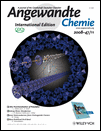Desorption Studies of Hydrogen in Metal–Organic Frameworks†
Barbara Panella Dr.
Max-Planck-Institut für Metallforschung, Heisenbergstrasse 3, 70569 Stuttgart, Germany, Fax: (+49) 711-689-1952
Search for more papers by this authorKatja Hönes
Max-Planck-Institut für Metallforschung, Heisenbergstrasse 3, 70569 Stuttgart, Germany, Fax: (+49) 711-689-1952
Search for more papers by this authorUlrich Müller Dr.
BASF Aktiengesellschaft, Chemicals Research & Engineering, 67056 Ludwigshafen, Germany
Search for more papers by this authorNatalia Trukhan Dr.
BASF Aktiengesellschaft, Chemicals Research & Engineering, 67056 Ludwigshafen, Germany
Search for more papers by this authorMarkus Schubert Dr.
BASF Aktiengesellschaft, Chemicals Research & Engineering, 67056 Ludwigshafen, Germany
Search for more papers by this authorHermann Pütter Dr.
BASF Aktiengesellschaft, Chemicals Research & Engineering, 67056 Ludwigshafen, Germany
Search for more papers by this authorMichael Hirscher Dr.
Max-Planck-Institut für Metallforschung, Heisenbergstrasse 3, 70569 Stuttgart, Germany, Fax: (+49) 711-689-1952
Search for more papers by this authorBarbara Panella Dr.
Max-Planck-Institut für Metallforschung, Heisenbergstrasse 3, 70569 Stuttgart, Germany, Fax: (+49) 711-689-1952
Search for more papers by this authorKatja Hönes
Max-Planck-Institut für Metallforschung, Heisenbergstrasse 3, 70569 Stuttgart, Germany, Fax: (+49) 711-689-1952
Search for more papers by this authorUlrich Müller Dr.
BASF Aktiengesellschaft, Chemicals Research & Engineering, 67056 Ludwigshafen, Germany
Search for more papers by this authorNatalia Trukhan Dr.
BASF Aktiengesellschaft, Chemicals Research & Engineering, 67056 Ludwigshafen, Germany
Search for more papers by this authorMarkus Schubert Dr.
BASF Aktiengesellschaft, Chemicals Research & Engineering, 67056 Ludwigshafen, Germany
Search for more papers by this authorHermann Pütter Dr.
BASF Aktiengesellschaft, Chemicals Research & Engineering, 67056 Ludwigshafen, Germany
Search for more papers by this authorMichael Hirscher Dr.
Max-Planck-Institut für Metallforschung, Heisenbergstrasse 3, 70569 Stuttgart, Germany, Fax: (+49) 711-689-1952
Search for more papers by this authorPartial funding by the European Commission DG Research (contract SES6-2006-518271/NESSHY) is gratefully acknowledged by the authors. We are also thankful to Annette Fuchs for measuring the nitrogen adsorption isotherms and to Bernd Ludescher for technical support.
Graphical Abstract
The diameter is decisive: Adsorption sites for hydrogen in the metal–organic frameworks Cu-BTC, MIL-53, MOF-5, and IRMOF-8 could be identified by using thermal desorption spectroscopy at very low temperatures (see graph). The correlation between the desorption spectra and the pore structure of these MOFs shows that at high hydrogen concentrations the diameter of the cavity determines the heat of adsorption.
Supporting Information
Supporting information for this article is available on the WWW under http://www.wiley-vch.de/contents/jc_2002/2008/z704053_s.pdf or from the author.
Please note: The publisher is not responsible for the content or functionality of any supporting information supplied by the authors. Any queries (other than missing content) should be directed to the corresponding author for the article.
References
- 1M. Eddaoudi, J. Kim, N. L. Rosi, D. Vodak, J. Wachter, M. O'Keeffe, O. M. Yaghi, Science 2002, 295, 469–472.
- 2T. Mueller, G. Ceder, J. Phys. Chem. B 2005, 109, 17974–17983.
- 3E. C. Spencer, J. A. K. Howard, G. J. McIntyre, J. L. C. Rowsell, O. M. Yaghi, Chem. Commun. 2006, 278–280.
- 4P. M. Forster, J. Eckert, B. D. Heiken, J. B. Parise, J. W. Yoon, S. H. Jhung, A. K. Cheetham, J. Am. Chem. Soc. 2006, 128, 16846–16850.
- 5C. Prestipino, L. Regli, J. G. Vitillo, F. Bonino, A. Damin, C. Lamberti, A. Zecchina, P. L. Scolari, K. O. Kongshaug, S. Bordiga, Chem. Mater. 2006, 18, 1337–1346.
- 6K. W. Chapman, P. J. Chupas, E. R. Maxey, J. W. Richardson, Chem. Commun. 2006, 4013–4015.
- 7S. H. Jhung, H.-K. Kim, J. W. Yoon, J.-S. Chang, J. Phys. Chem. B 2006, 110, 9371–9374.
- 8H. Chun, D. N. Dybtsev, H. Kim, K. Kim, Chem. Eur. J. 2005, 11, 3521–3529.
- 9M. Dinca, J. R. Long, J. Am. Chem. Soc. 2005, 127, 9376–9377.
- 10Y. Liu, C. M. Brown, D. A. Neumann, V. K. Peterson, C. J. Kepert, J. Alloys Compd. 2007, 446–447, 385–388.
- 11H. Frost, T. Düren, R. Q. Snurr, J. Phys. Chem. B 2006, 110, 9565–9570.
- 12V. K. Peterson, Y. Liu, C. M. Brown, C. J. Kepert, J. Am. Chem. Soc. 2006, 128, 15578–15579.
- 13S. S.-Y. Chui, S. M.-F. Lo, J. P. H. Charmant, A. G. Orpen, I. D. Willis, Science 1999, 283, 1148–1150.
- 14P. Krakiew, M. Kramer, M. Sabo, R. Kunschke, H. Fröde, S. Kaskel, Adv. Eng. Mater. 2006, 8, 293–296.
- 15A. Vishnyakov, P. I. Ravikovitch, A. V. Neimark, M. Bülow, Q. M. Wang, Nano Lett. 2003, 3, 713–718.
- 16T. Loiseau, C. Serre, C. Huguenard, G. Fink, F. Taulelle, M. Henry, T. Bataille, G. Férey, Chem. Eur. J. 2004, 10, 1373–1382.
- 17J. L. C. Rowsell, E. C. Spencer, J. Eckert, J. A. K. Howard, O. M. Yaghi, Science 2005, 309, 1350–1354.
- 18U. Mueller, M. Schubert, F. Teich, H. Puetter, K. Schierle-Arndt, J. Pastré, J. Mater. Chem. 2006, 16, 626–636.
- 19N. L. Rosi, M. Eddaoudi, J. Kim, M. O'Keeffe, O. M. Yaghi, CrystEngComm 2002, 4, 401–404.
- 20B. Panella, M. Hirscher, H. Pütter, U. Müller, Adv. Funct. Mater. 2006, 16, 520–524.
- 21A. G. Wong-Foy, A. J. Matzger, O. M. Yaghi, J. Am. Chem. Soc. 2006, 128, 3494–3495.
- 22H. W. Langmi, D. Book, S. R. Johnson, M. M. Al-Mamouri, J. D. Speight, P. P. Edwards, I. R. Harris, P. A. Anderson, J. Alloys Compd. 2005, 404–406, 637–642.
- 23B. Panella, M. Hirscher, S. Roth, Carbon 2005, 43, 2209–2214.
- 24S. S. Kaye, J. R. Long, Catal. Today 2007, 120, 311–316.
- 25J. L. C. Rowsell, J. Eckert, O. Yaghi, J. Am. Chem. Soc. 2005, 127, 14904–14910.
- 26B. Panella, M. Hirscher, B. Ludescher, Microporous Mesoporous Mater. 2007, 103, 230–234.
- 27J. L. C. Rowsell, A. R. Millward, K. S. Park, O. M. Yaghi, J. Am. Chem. Soc. 2004, 126, 5666–5667.
- 28V. Krungleviciute, K. Lask, L. Heroux, A. D. Migone, J.-Y. Lee, J. Li, A. Skoulidas, Langmuir 2007, 23, 3106–3109.
- 29A. Dailly, J. J. Vajo, C. C. Ahn, J. Phys. Chem. B 2006, 110, 1099–1101.
- 30J. L. C. Rowsell, O. M. Yaghi, J. Am. Chem. Soc. 2006, 128, 1304–1351.





